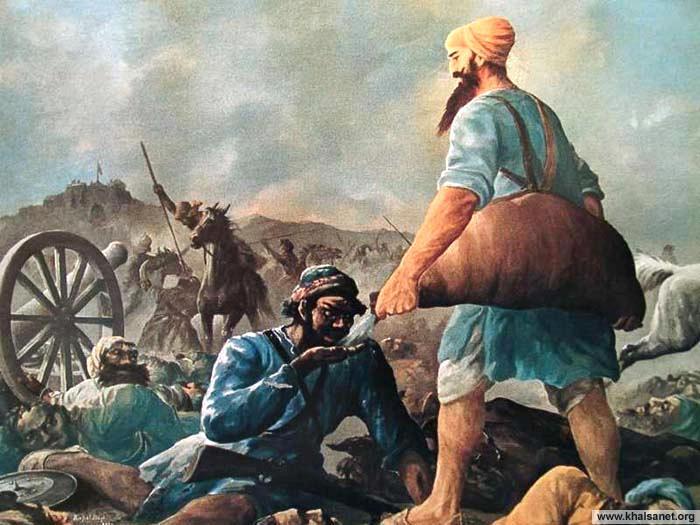The history of the Sikhs is still very young when it is given a son especially blessed by VĀHIGURŪ JĪ. HE had destined this son to light a fire of charity whose comforting flames should never go out and would reach the hearts of many generations after him.
The story begins in Sodharā near Vazīrābād, in the province of Siālkoṭ, which today is encircled by the Pākistāni border. It is the year 1648 when a son, Bhāī Kanhaīā is born to happy parents in the rich merchant family Dhamman Khattrī. But Bhāī Kanhaīā's heart is not set on the riches of a wealthy family. GOD had aroused in him the desire for HIS riches, and Bhāī Kanhaīā left his parents while still very young in order to go on the search for religious fulfilment together with ascetics and Sadhus. His deep desire was fulfilled the moment the SATGURŪ let him meet Gurū Teg Bahādar Jī and he was accepted as his disciple. The young Bhāī Kanhaīā, full of devotion and deeply felt love, served Gurū Teg Bahādar Jī, and when the time for parting had come, the Gurū's smile rested on him and made him follow the path of GOD, which he had set himself on, in another place.
This place was the village of Kāvhā in the district of Aṭṭak, where Bhāī Kanhaīā had a Dharmsālā built in order to instruct the villagers in the teaching of the Sikhī. Especially remarkable was the care with which Bhāī Kanhaīā again and again pointed out the virtues of unconditional charity and unprejudiced helpfulness.
Time keeps turning over its pages with its characteristic regularity and in doing so writes history. It writes November 11, 1675, in bold letters, the day that Gurū Teg Bahādar Jī suffers a martyr's death in Dillī, and it knows that Gobind Rāe, his son, is the new Gurū.
And in the abundant drapery of its dress, time has also preserved Bhāī Kanhaīā's destiny:
GOD's blessing which rested on Bhāī Kanhaīā had not yet been fulfilled with the teaching of the Sikhī in Kāvhā. So in the year 1704 / 1705, HE led him to the city of Anandpur Sāhib, whose air was heavy with the smoke and the fire of the attacks of the Mogul's soldiers and of mountaineers who had come to destroy Gurū Gobind Singh Jī.
Blood, battles, the last sighs of mortally wounded soldiers, and on both sides soldiers groaning with pain in puddles of blood. And after every battle the miracle of unconditional charity and unfaltering helpfulness comes to the horrifying place and attends to friends and foes with everything they need: Bhāī Kanhaīā.

Where there is light there is shadow: Sikhs were mistrustful towards Bhāī Kanhaīā because he attended to the enemy just like to his own people, and one day they became so indignant they rushed to see Gurū Gobind Singh to tell him about Bhāī Kanhaīā's infamous deeds. The Gurū patiently listened to their accusations and then had Bhāī Kanhaīā called to see him so he could ask him whether all this really was true.
The sources give different answers that Bhāī Kanhaīā made. All of them are beautiful:
''Yes, my great Gurū, that is true.''
''Why are you doing this?''
''For me, oh my Gurū, there is neither friend nor foe (na koī merā duśman rahe, na ham kis ke vair).''
''Oh great Gurū, I see only you. My Gurū is in every human being. I cannot distinguish between you, Sikhs and enemies.''
''Yes, my great Gurū, it is true what the Sikhs say. But I did not see friends or foe or Hindūs or Muslims. My great Gurū, in every face I always saw only your face and acted accordingly.''
Gurū Gobind Singh praised Bhāī Kanhaīā's noble virtues in front of all the Sikhs present and said that he alone had understood the message of Sikhism. After the evacuation of Anandpur Sāhib Bhāī Kanhaīā, the beacon of charity, withdrew to Sodharā, where, in the year 1718, he shut his eyes for ever.
A late appreciation was extended to Bhāī Kanhaīā in 1859 when the Swiss merchant Henri Durant (May 8, 1828 – October 30, 1910), who founded the Red Cross as a global organization for the wounded, the sick and the persecuted, called Bhāī Kanhaīā, the Sevā Panthī from the Pañjāb, a forerunner of the Red Cross.
Note: This story is from my eBook For Sikhs and Sikhism – Behind the Song there Stands a Smithy which you can download here. ~ Elisabeth Meru

